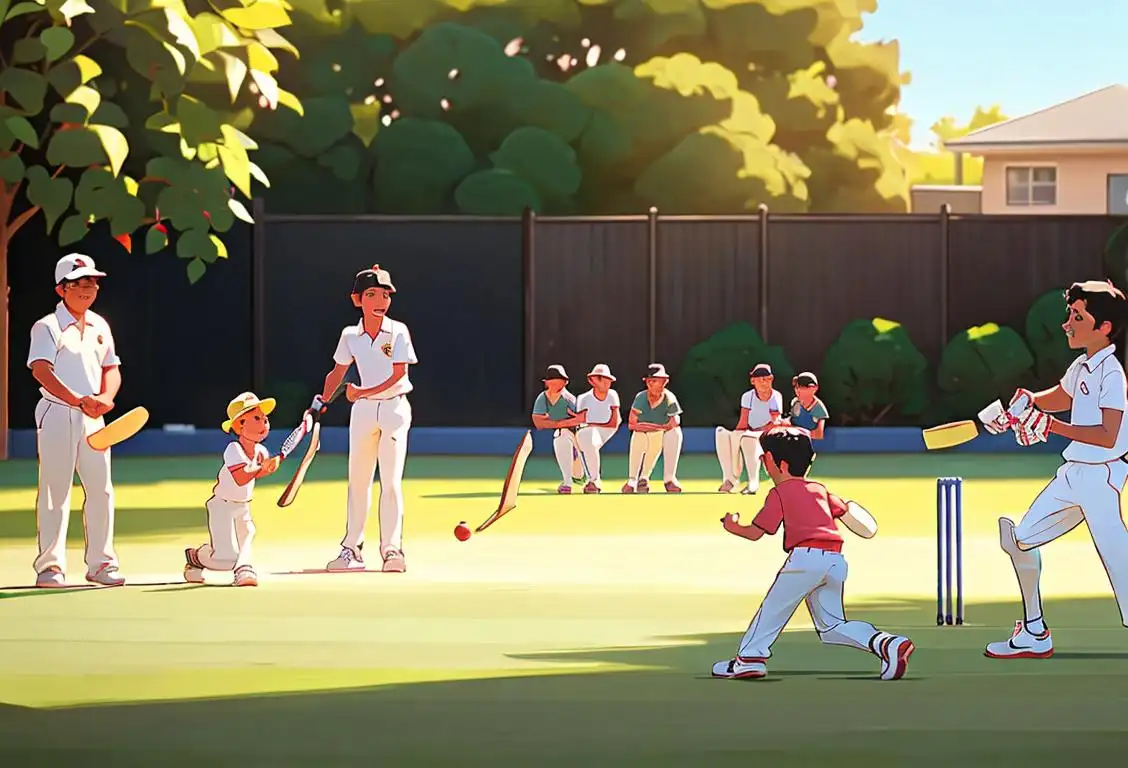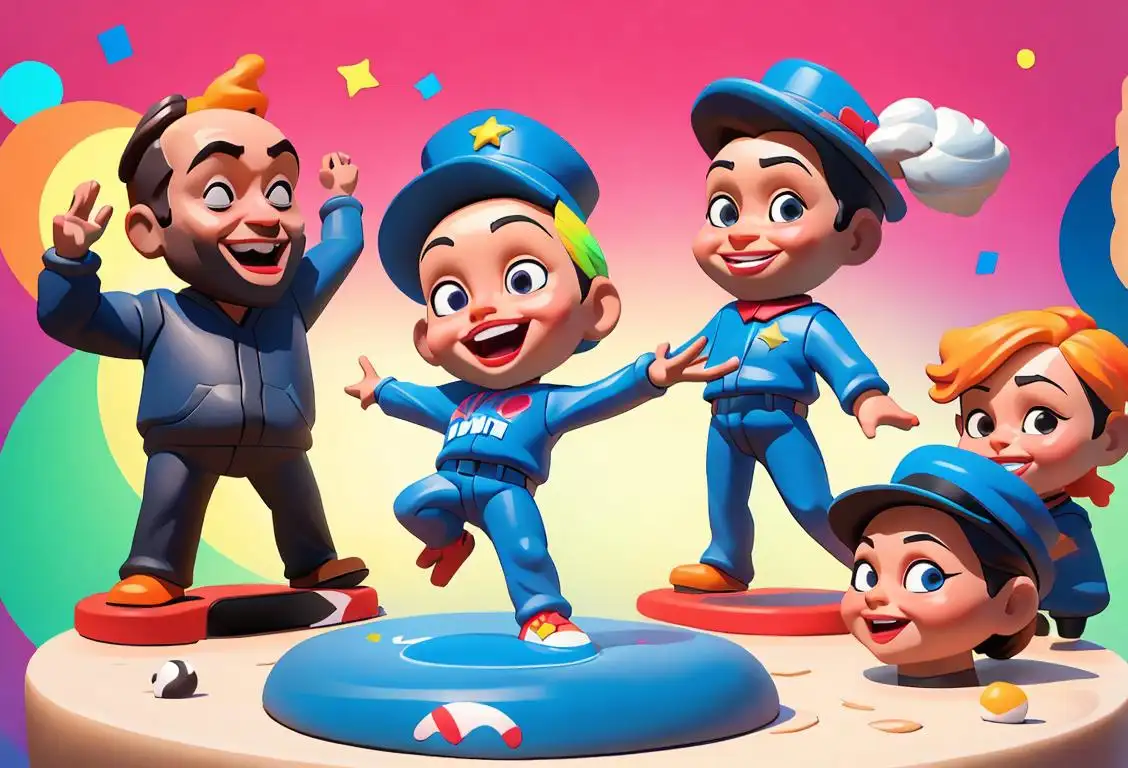National Backyard Cricket Day

Welcome to the wacky world of National Backyard Cricket Day! This day is all about bringing out your inner cricketer and having a ball with your loved ones in your very own backyard. So grab your bat, put on your cricket whites, and prepare for a day filled with fun, laughter, and maybe even a little healthy competition.
When is Backyard Cricket Day?
It's national backyard cricket day on the 12th January.
The Internet History of National Backyard Cricket Day
Backyard cricket is a beloved tradition in many countries, especially in Australia, where it is almost considered a national sport. National Backyard Cricket Day, however, is a relatively new addition to the calendar.
The idea for National Backyard Cricket Day emerged on social media in recent years, as cricket enthusiasts around the world realized that they all shared a love for playing cricket in their own backyards. They wanted to create a day dedicated to celebrating this cherished pastime and embracing the spirit of friendly competition.
On National Backyard Cricket Day, families and friends gather in their backyards or local parks to set up their own makeshift cricket pitches. The rules are often relaxed, with an emphasis on having fun rather than strict adherence to traditional cricket rules. It's a day when everyone can get involved, regardless of their cricketing skills or experience.
One of the great things about National Backyard Cricket Day is that it brings people together. It's a time when friends and families can bond over a shared love of cricket, enjoying a day of sport, laughter, and, of course, some delicious food and drinks.
Did You Know?
Did you know that the longest recorded game of backyard cricket lasted for a whopping 51 hours? That's right! A group of dedicated cricket enthusiasts in Australia played continuously for over two days, breaking previous records and proving that cricket knows no bounds, even in a backyard setting. The players showed incredible endurance and dedication, making it a memorable event in the history of National Backyard Cricket Day.
History behind the term 'Backyard Cricket'
1840
Beginnings of cricket in Australia
Cricket was introduced to Australia by British settlers in the early 19th century. It quickly gained popularity, becoming one of the country's favorite sports. Matches were initially played on formal grounds.
early 19th century
Origins in England
Backyard cricket, also known as garden cricket, originated in England in the early 19th century. It was played in the backyards of homes by families and neighbors, offering a fun and informal way to enjoy the sport. The game became popular due to its accessibility, as people could play without the need for a formal cricket ground or equipment.
1830
Origins in rural Australia
Backyard cricket originated in the 1830s in rural Australia. The game was played as a social pastime by farmers and their families during their leisure time. It provided a fun and entertaining way to relax and enjoy the outdoors. The open spaces of the backyard were transformed into impromptu cricket fields, complete with makeshift wickets and bats.
1850
Informal beginnings
Backyard cricket originated in the mid-19th century in Australia, during the early days of British colonial settlement. The game was played informally in the backyards of homes, with improvised equipment and rules. It was a popular pastime among children, families, and friends, providing a fun and accessible form of recreation.
19th century
The Early Days
Backyard cricket began in Australia during the 19th century when cricket was gaining popularity as a national sport. The game was played in the backyards of Australian houses, primarily by children and amateur players. It provided a way for families and friends to come together and enjoy a friendly match in a relaxed setting.
1800s
Early Origins
During the 1800s, informal cricket matches began to be played in the backyards of homes in England. These matches were a way for friends and families to enjoy the sport in a more relaxed and casual setting compared to formal matches played in stadiums. Backyard cricket quickly gained popularity due to its accessibility and enjoyment factor.
1743
Origins of cricket
Cricket, a bat-and-ball game, originated in England and was played as early as the 16th century. It quickly became a popular pastime for people of all ages and social classes. The game spread to other countries through British colonialism, including Australia.
1700s
Early Roots
The origins of backyard cricket can be traced back to the 1700s in England, where the game of cricket was already popular. The term 'backyard cricket' refers to the informal version of the game played in the open spaces behind houses or in local neighborhoods. It was a way for people to enjoy cricket without the need for dedicated cricket grounds or formal teams. Backyard cricket allowed people of all ages and skill levels to participate, making it a popular pastime for families and friends.
1930s
The Invention of the Stump Wicket
In the 1930s, the concept of using a stump as a wicket emerged in backyard cricket. Instead of having a formal set of stumps and bails, players would use an object like a brick or a garbage bin as a makeshift wicket. This innovation added a sense of improvisation and creativity to the game, making it more accessible and enjoyable for everyone.
1880
Spread to urban areas
By the 1880s, backyard cricket had spread beyond the rural areas and gained popularity in urban regions of Australia. The game was embraced by city-dwellers as a way to recreate the rural lifestyle and connect with their roots. It became a common sight to see neighborhoods bustling with friendly matches played in backyards, parks, and even on the streets.
1800s
Colonial Influence
In the 1800s, during the era of British colonialism, the game of cricket spread to various parts of the world, including Australia. British settlers brought their love for cricket with them, and it soon became an integral part of the Australian sporting culture. As cricket gained popularity in Australia, so did backyard cricket, as it provided a way for people to enjoy the game in their own homes or local parks.
Early 1900s
Spread to the Commonwealth
As cricket became popular in England, it was brought to various regions of the Commonwealth, including Australia, New Zealand, and South Africa. Backyard cricket became a cherished tradition in these countries as well, providing a fun and social way for people to come together and participate in the sport.
1870
Spread of popularity
During the 1870s, backyard cricket gained even more popularity in Australia. As the rules began to take shape and become standardized, matches became more structured and competitive. The game was played on various surfaces, including grass, compacted soil, or even sand. With minimal equipment requirements, it remained a common and accessible sport for people of all ages and social backgrounds.
1870s
Spread to Australia
During the 1870s, backyard cricket found its way to Australia with the influx of British settlers. The game quickly gained popularity in the country, becoming a cherished part of Australian culture. Australians embraced backyard cricket as a way to bond with friends and family during their leisure time, especially during summer months when the weather was warm and ideal for outdoor activities.
1803
The birth of backyard cricket
Backyard cricket, also known as street cricket, evolved as a variation of traditional cricket. With limited space and a lack of formal playing areas, children and adults in Australia started playing cricket in their backyards or on the streets. Backyard cricket became a beloved pastime, promoting camaraderie and friendly competition among friends and neighbors.
Mid-19th century
Informal matches on streets and open spaces
As cricket grew in popularity, people started playing informal matches in streets, parks, and various open spaces. These matches provided an opportunity for people to gather and enjoy the sport in a more casual setting.
20th century
Informal yet competitive
Throughout the 20th century, backyard cricket continued to be played as an informal yet competitive game. It was often seen as a social gathering, bringing communities together and fostering a sense of camaraderie. Backyard cricket matches would feature rules tailored to the available space and resources, allowing players to adapt the game to their surroundings.
Late 19th century
Backyard cricket becomes a term
During this period, the term 'backyard cricket' began to be used to describe the informal matches played in residential areas. It referred to the practice of playing cricket in the spacious yards or gardens behind houses, where makeshift pitches were set up. Backyard cricket became a popular pastime for families and friends.
1930s
Improvisations and rule changes
As backyard cricket became more popular, players started adapting the rules to suit the limited space and available equipment. They used various types of balls, such as tennis balls and rubber balls, to play the game. The rules were simplified to accommodate fewer players and smaller playing areas, allowing anyone to join in the fun.
Mid 1900s
Informal Matches and Street Cricket
During the mid-1900s, backyard cricket evolved further into informal matches played on streets and other public spaces. Children and even adults would gather to play cricket with makeshift bats, balls, and wickets. Street cricket became a common sight in many neighborhoods, fostering a sense of community and bringing people together.
1950s
The Rise of Self-Officiating
During the 1950s, backyard cricket embraced the idea of self-officiating. Unlike professional cricket matches that require umpires, backyard cricket relied on the honor system, with players making their own decisions regarding dismissals and other aspects of the game. This element of trust and fair play became an integral part of the backyard cricket culture.
20th century
Cultural significance
By the 20th century, backyard cricket had become deeply ingrained in Australian culture. It became synonymous with summer holidays, family gatherings, and social bonding. Matches were often fiercely competitive but maintained a relaxed and jovial atmosphere. The informal nature of the game allowed for creative variations and adaptations, adding to its appeal and ensuring its enduring popularity.
20th Century
Informal Traditions
Throughout the 20th century, backyard cricket continued to flourish as an informal, recreational form of the game. It was commonly played during family gatherings, picnics, and informal social events. The rules of the game were often adapted to suit the available space and number of players. Backyard cricket became a cherished tradition, bringing people together and fostering a sense of community and camaraderie.
1912
Influence of test cricket
The early 20th century saw a significant influence of test cricket on backyard cricket. Test cricket, a highly recognized form of the sport, played a crucial role in shaping the rules and techniques of backyard cricket. The informal games started adopting elements of test cricket, including the use of traditional cricket gear, such as cricket bats and balls. This led to a more standardized version of the game in people's backyards.
1980s
Cultural Phenomenon
In the 1980s, backyard cricket in Australia gained significant recognition and popularity. It became a cultural phenomenon, often associated with Australian summer traditions and the festive holiday season. Backyard cricket games were frequently played on Christmas Day, with families and friends coming together to enjoy the sport. The informal nature of the game, combined with its accessibility and inclusivity, made it a beloved part of Australian identity.
1990s
Professionalization and media exposure
In the 1990s, backyard cricket received significant media exposure, especially in Australia. The game became a symbol of Australian culture, with many professional cricketers recalling their childhood experiences playing in backyards. Backyard cricket matches were televised, and coverage included celebrity matches played for charity. The professionalization and media attention brought wider recognition to the term 'backyard cricket'.
Late 1900s
Cultural Phenomenon
By the late 1900s, backyard cricket had become more than just a casual game. It had transformed into a cultural phenomenon, deeply woven into the social fabric of communities. It became associated with summer holidays, family gatherings, and friendly competitions. Backyard cricket even found its way into popular culture, being referenced in books, movies, and songs.
20th century
Improvisations and unique rules
As backyard cricket evolved, players started introducing improvisations and unique rules to accommodate the limited space and number of participants. Rules such as 'one-hand, one bounce' and 'six and out' were commonly used, adding an element of fun and creativity to the game.
1950
Family bonding and community spirit
During the 1950s, backyard cricket became an integral part of family gatherings and community events in Australia. It provided an opportunity for family members, friends, and neighbors to gather and bond over a shared passion for the game. Backyard cricket tournaments and competitions further enhanced the social fabric of the communities, fostering a sense of camaraderie and friendly competition.
1980s
The Iconic Kanga Cricket Ball
In the 1980s, the Kanga cricket ball gained popularity in backyard cricket. The Kanga ball, made of tennis ball material covered with a light felt, provided a safer alternative to hard cricket balls, reducing the risk of injury during informal matches. It allowed players to play with more confidence and freedom, resulting in an increase in backyard cricket participation.
1960s
Backyard cricket gains prominence
Backyard cricket gained even more prominence in Australian culture during the 1960s. With the advent of television and the popularity of cricket broadcasts, people were exposed to the professional version of the sport. This led to a greater interest in playing cricket at home, with families and friends coming together for matches in their own backyards.
Post-World War II
Post-war resurgence
After World War II, backyard cricket experienced a resurgence in popularity. The return of soldiers and the rise of suburban living led to an increase in suburban backyard spaces, providing ample room for cricket matches. With the advent of television, cricket matches were also being broadcast, further fueling interest and enthusiasm for the sport. Backyard cricket became a cherished tradition, connecting generations and fostering a sense of community.
2006
Recognition as a national pastime
In 2006, backyard cricket was officially recognized as a national pastime in Australia. The game symbolizes the laid-back Australian lifestyle and the love for sport. It is an integral part of the Australian identity, celebrated during national holidays like Australia Day and Boxing Day. The term 'backyard cricket' has become synonymous with summer, fun, and the Australian way of life.
Present Day
Continued Enjoyment
Today, backyard cricket remains a cherished tradition in Australia and in other parts of the world where cricket is played. It is a reflection of the informal and community-driven nature of the sport. Backyard cricket continues to bring people together, fostering social connections and providing a platform for friendly competition and enjoyment. Whether played in urban backyards, village greens, or local parks, backyard cricket upholds the spirit of the game in a relaxed and accessible manner.
Present day
Continued popularity and variations
Backyard cricket remains immensely popular in Australia and other cricket-loving nations. It has become an integral part of social gatherings, holiday festivities, and backyard barbecues. Modern variations of the game include tape-ball cricket, beach cricket, and even inflatable cricket sets designed for small spaces. The term 'backyard cricket' has come to represent the spirit of informal yet passionate cricket played in a relaxed and joyous environment.
Present day
Continued tradition and evolution
Backyard cricket remains an integral part of Australian culture to this day. It continues to be played in backyards, parks, and beaches throughout the country, contributing to the development of cricketing talent. The game has also evolved beyond Australia's borders, with variations played in other cricket-loving nations. Despite its informal nature, backyard cricket has left a lasting impact on the nation's sporting heritage, serving as a symbol of camaraderie, adaptability, and the love for the game.
Present day
Backyard cricket continues to thrive
Backyard cricket remains a beloved tradition in Australia and other cricket-playing nations. It symbolizes the cherished moments spent with family and friends, fostering a sense of camaraderie and community. Many Australians have fond memories of playing backyard cricket during celebrations and gatherings.
1970s
Backyard cricket tournaments and traditions
During the 1970s, backyard cricket became a highly organized activity with tournaments and official rules. Families and neighborhoods would host their own backyard cricket competitions, complete with team selections, umpires, and scoring systems. The games often involved traditions like using makeshift wickets, modified bats, and unique rules that added an extra layer of excitement and creativity to the matches.
Present Day
Continued Tradition and Global Influence
Backyard cricket continues to be a cherished tradition, not only in Australia but also in various countries around the world. It promotes inclusivity, encourages friendly competition, and provides an informal platform for cricket enthusiasts of all ages and skill levels to enjoy the game. Whether it's played in backyards, parks, or even on beaches, backyard cricket remains a beloved pastime that brings people together.
Present day
Backyard cricket as a cultural phenomenon
Backyard cricket continues to be a cherished tradition in Australia and other cricket-playing nations. It is not only a fun game but also a way to connect with friends, bond with family, and celebrate community spirit. Many notable cricketers, including international stars, have fond memories of their early experiences playing backyard cricket, which often served as a stepping stone to their professional careers.
Did you know?
Did you know that the longest recorded game of backyard cricket lasted for a whopping 51 hours?Tagged
fun loved ones sportsFirst identified
12th January 2021Most mentioned on
12th January 2021Total mentions
14Other days
Suicide Prevention Month Day
Happiness Day
Drink A Beer Day
Trivia Day
Cancer Survivors Day
Take A Hike Day
Memorial Day
Foundation Day
Bobblehead Day
Bowling Day









